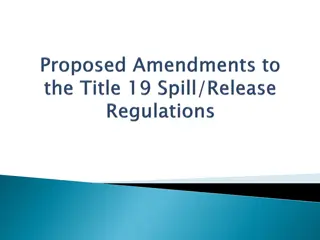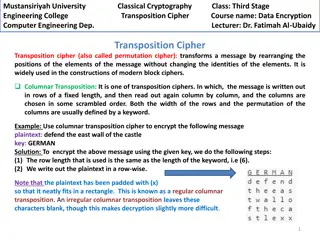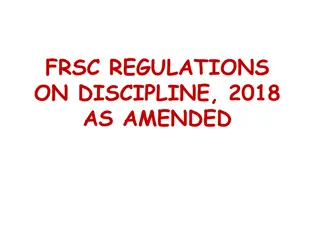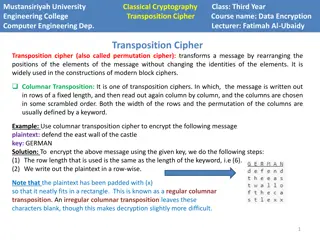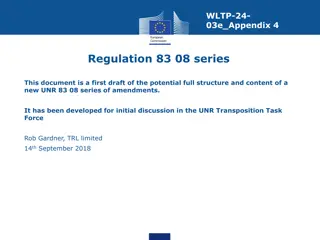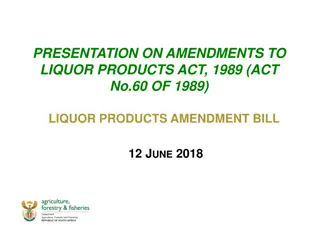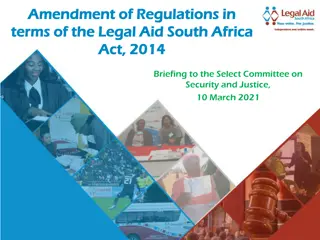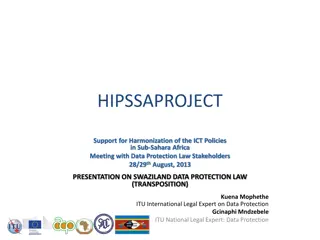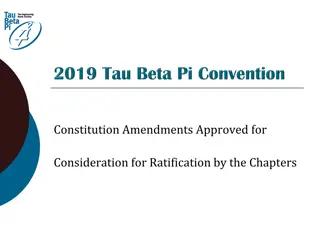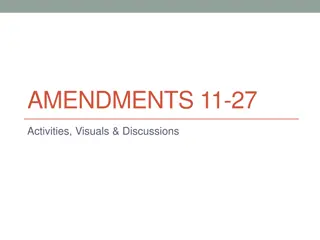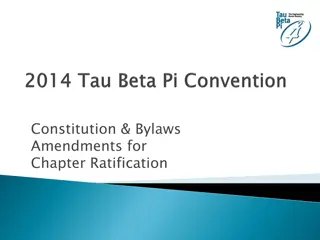Transposition of GTR20 into UN Regulations: Draft Amendments Overview
Japan and the European Commission are aligning with the administrative provisions of the UN 98 Agreement by transposing GTR20 into UN Regulations. The proposed amendments focus on incorporating technical provisions of GTR20 into existing UNRs while maintaining clarity on scope and safety requirements for electric vehicles to enhance regulatory alignment with EVS-GTR.
Download Presentation

Please find below an Image/Link to download the presentation.
The content on the website is provided AS IS for your information and personal use only. It may not be sold, licensed, or shared on other websites without obtaining consent from the author. Download presentation by click this link. If you encounter any issues during the download, it is possible that the publisher has removed the file from their server.
E N D
Presentation Transcript
Submitted by the expert from Japan on behalf of Task Force Informal document GRSP-66-31 (66th GRSP, 10-13 December 2019, agenda items 15, 16, 17 and 24 ) Transposition of GTR20 (EVS-GTR) to UN Regulations Introduction of the drafts for; 03 series of amendments to UN Regulation No.100 04 series of amendments to UN Regulation No.94 05 series of amendments to UN Regulation No.95 02 series of amendments to UN Regulation No.137 1
1. Motivations Japan and the European Commission are willing to follow the administrative provisions of UN 98 Agreement (Article 7.1) by applying UN Regulations aligned with EVS-GTR Therefore, the two CPs have been developed the amendments of relevant UNRs OICA supported the transposition process by providing their expertise The amendment considered in ECE/TRANS/WP.29/GRSP/2019/17 is merged into this document. The amendments proposed by the European Commission for the extension of the scope of crash regulations (UNR 94, 137 and 95) were assumed to be adopted ahead of the amendments for transposing GTR 2
2. Concept Incorporate technical provisions of GTR20 into existing UNR, if any Maintain the structure of relevant UNRs New UNR on Rr impact (GRSP/2019/38) will also be aligned to GTR20 <Requirements of GTR20> <Vehicle> <Component> R100 Part 1 Electrical safety (in-use) Mfr s choice Electrical safety (post-crash) R100 Part 2 Functionality, Warning R94 Mfr s choice REESS installation R137 REESS safety (in-use) R95 REESS safety (post-crash) New (Rr Impact) 3
3. Amendment of UNR100 (EV Safety) Beside transposition of technical provisions of GTR20, the following pointes were specifically considered: (1) Clarification of SCOPE (para.1) <Scope of GTR20> vehicles of Category 1 and Category 2 with a maximum design speed exceeding 25 km/h, equipped with electric power train containing high voltage bus, excluding vehicles permanently connected to the grid. <Scope of UNR100-02 (current version)> Part I: Safety requirements with respect to the electric power train of road vehicles of categories M and N , with a maximum design speed exceeding 25 km/h, equipped with one or more traction motor(s) operated by electric power and not permanently connected to the grid, as well as their high voltage components and systems which are galvanically connected to the high voltage bus of the electric power train. Part II: Safety requirements with respect to the Rechargeable Energy Storage System (REESS), of road vehicles of categories M and N equipped with one or more traction motors operated by electric power and not permanently connected to the grid. GTR s scope is limited to vehicles with high voltage system, while current UNR applies also to low voltage REESS and vehicles having such a REESS In UNR, component approval of REESS had been adopted to allow flexibility in the business scheme between vehicle manufacturers and system suppliers Maintain current scope with clarification 4
3. Amendment of UNR100 (EV Safety) (1) Clarification of SCOPE (para.1) <Scope of UNR100-03 (proposal)> 1.1. Part I: Safety requirements with respect to the electric power train of road vehicles of categories M and N, with a maximum design speed exceeding 25 km/h, equipped with electric power train, excluding vehicles permanently connected to the grid one or more traction motor(s) operated by electric power and not permanently connected to the grid, as well as their high voltage components and systems which are galvanically connected to the high voltage bus of the electric power train. Part I of this regulation does not cover; post-crash safety requirements of road vehicles. (a) Post-crash safety requirements of road vehicles. (b) High voltage components and systems which are not galvanically connected to the high voltage bus of the electric power train. 1.2. Part II: Safety requirements with respect to the Rechargeable Electrical Energy Storage System (REESS), of road vehicles of categories M and N equipped with electric power train, excluding vehicles one or more traction motors operated by electric power and not permanently connected to the grid. Part II of this Regulation does not apply to a batteryREESS(s) whose primary use is to supply power for starting the engine and/or lighting and/or other vehicle auxiliaries systems. [Primary use in this context means that more than 50% of the energy from the battery is used for starting the engine and/or lighting and/or other vehicle auxiliaries systems over an appropriate driving cycle, e.g. WLTC for M1 and N1.] Additional sentence for numerical threshold for differentiating REESS or not is still under discussion 5
3. Amendment of UNR100 (EV Safety) (2) Distribution of REESS related warning requirements (para. 5.2.3, 6.13-15) GTR has additional requirements for waring in the event of REESS failure For UNR, these requirements are separated to vehicle level (warning indication) and REESS level (sensing and signaling) (3) Protection against water (para.5.1.4, Annex 6) In GTR, allowing compliance alternative of isolation resistance monitoring system is CP option For UNR, this option is adopted as it is considered as effective Technical correction to the test procedure of isolation resistance monitoring system (Annex 6) (4) Preventing accidental or unintended vehicle movement (para.5.3) The title of this requirement is changed from functional safety to above, to avoid confusion NL proposal (ECE/TRANS/WP.29/GRSP/2019/17) is merged into this amendment (5) REESS post-crash safety (para. 6.4.1.1 & 6.4.2.1.1) GTR does not specify the crash configurations Crash configurations of current R100-02 (i.e. Frontal impact and Lateral impact) are carried over, but adopt R137 instead of R12 Crash regulations (R94, 95, 137) will include additional criterion for REESS fire hazard and becomes alternative to these requirements 6
3. Amendment of UNR100 (EV Safety) (6) Adaptation of administrative provisions (para. 4, 7, 8, 9, 10) Administrative provisions are simplified by referring to the Schedules of Rev.3 of the 58 Agreement Recent practices in other UNRs are introduced (7) Transitional provisions (para. 12) Recommend to have a reasonable period from the entry into force for new type of vehicles 7
4. Amendment of UNR94 &137 (Frontal impact) Beside transposition of technical provisions of GTR20, the following pointes were specifically considered: (1) New series of amendments only affecting to vehicles with electric power train Strengthened criteria (e.g. low energy criterion 2.0J 0.2J) and different test conditions are introduced by GTR20 Voltage measurement for physical protection (CP option in GTR) is not adopted since there has been no issues identified from the implementation of relevant requirements of current UNRs (2) Adaptation of administrative provisions (para. 4, 7, 8, 9, 10) Administrative provisions are simplified by referring to the Schedules of Rev.3 of the 58 Agreement Recent practices in other UNRs are introduced (3) Transitional provisions (para. 12) Recommend to have a reasonable period from the entry into force for new type of vehicles Vehicles not having an electric power train operating on high voltage are not affected by this series of amendments and therefore existing approval should not be affected 8
5. Amendment of UNR95 (Lateral impact) Beside transposition of technical provisions of GTR20, the following pointes were specifically considered: (1) New series of amendments only affecting to vehicles with electric power train Strengthened criteria (e.g. low energy criterion 2.0J 0.2J) and different test conditions are introduced by GTR20 Voltage measurement for physical protection (CP option in GTR) is not adopted since there has been no issues identified from the implementation of relevant requirements of current UNRs (2) Adaptation of administrative provisions (para. 4, 6, 7, 8, 9) Administrative provisions are simplified by referring to the Schedules of Rev.3 of the 58 Agreement Recent practices in other UNRs are introduced (3) Transitional provisions (para. 11) Recommend to have a reasonable period from the entry into force for new type of vehicles Vehicles not having an electric power train operating on high voltage are not affected by this series of amendments and therefore existing approval should not be affected 9
6. Treatment of UN Regulation No.12 Frontal impact test of current R12 (Annex 3) is merely used, because the relevant requirements R94 or R137 are used as the alternatives If the scope of UN Regulation No.137 is extended to category N1, the need of frontal impact test will not be justified anymore The WG decided to suspend the amendment of R12 and to seek for guidance from GRSP Possible directions: A) Reform R12 as a component approval of replacement steering systems by removing vehicle level requirements B) Remove frontal impact test and its requirements (incl. electrical safety) C) Maintain existing structure and align with GTR20 10



